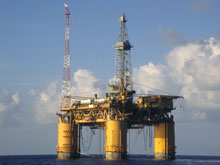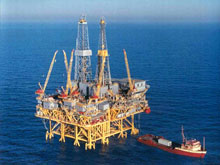
Figure 1. The Joliet first Gulf Tension Leg Platform, a potential sampling site during the cruise. Click image for larger view and image credit.

Figure 2. The Bulwinkle platform in the Gulf of Mexico. Click image for larger view and image credit.
Management and Protection of Deepwater Coral Habitats
Greg Boland,
Minerals Management Service,
U.S. Department Of The Interior
The Minerals Management Service (MMS), a bureau in the U.S. Department of the Interior, is the Federal agency that manages the nation's natural gas, oil, renewable alternative energy and other mineral resources on the outer continental shelf. One of the fundamental missions of the MMS is to identify and consider the protection of sensitive biological habitats in U.S. Federal waters. The oil and gas industry continues to move into deeper and deeper water in the search for extractable energy reserves in the Gulf of Mexico. Knowledge of the distribution, relative abundance, and population structures of deepwater organisms provides critical information to estimate the potential effects of deepwater exploration and production and allow refinement of management decisions and protective measures.
The MMS has been at the forefront of deep-water coral research in the Gulf of Mexico since the early 1990’s as part of their mandate to manage the nation's mineral resources in deeper federal waters together with protection of the environment. The largest and best developed deepwater coral habitat currently known in the Gulf, located in lease block Viosca Knoll 826, about 65 miles east of the mouth of the Mississippi River, was first studied in 1990 in conjunction with a MMS required site survey of the area prior to exploratory drilling for hydrocarbon reserves. This site and one other spectacular deepwater coral habitat were specifically targeted by a project that utilized the Navy submersible NR 1 resulting in the MMS publication MMS 2007-035 ![]() (Adobe .pdf file, 3.6 Mb). It is not known if similar remarkable coral habitats are located in other parts of the Gulf or if they are indeed extremely rare.
(Adobe .pdf file, 3.6 Mb). It is not known if similar remarkable coral habitats are located in other parts of the Gulf or if they are indeed extremely rare.
The first dedicated deepwater coral study in the Gulf of Mexico, Characterization of Northern Gulf of Mexico Deepwater Hard Bottom Communities with Emphasis on Lophelia Coral was an important step in gaining knowledge of previously unknown sensitive biological habitats in the deep Gulf of Mexico. The resulting final report is available on the MMS internet site as report MMM 2007-044 ![]() (Adobe .pdf file, 10.4 Mb). This initial study has proven to be very enlightening but significant unanswered questions remained that are the objectives of this new project including exploration of new potential habitats and focused studies and process-oriented research that will further develop an understanding of the distribution of deep coral habitats. We are only just beginning to understand the ecological aspects of cold-water corals, including the environmental factors of temperature, salinity, nutritional sources, reproductive biology, molecular genetics, predation, and parasitism which regulate their life histories and distribution. Past research has clearly demonstrated that deepwater coral habitats are important biodiversity hotspots and significant biological resources with intrinsic and socio-economic value.
(Adobe .pdf file, 10.4 Mb). This initial study has proven to be very enlightening but significant unanswered questions remained that are the objectives of this new project including exploration of new potential habitats and focused studies and process-oriented research that will further develop an understanding of the distribution of deep coral habitats. We are only just beginning to understand the ecological aspects of cold-water corals, including the environmental factors of temperature, salinity, nutritional sources, reproductive biology, molecular genetics, predation, and parasitism which regulate their life histories and distribution. Past research has clearly demonstrated that deepwater coral habitats are important biodiversity hotspots and significant biological resources with intrinsic and socio-economic value.
Processes within MMS for management and protection of deepwater biological resources include a standard biological review procedure for all industry-submitted plans for deepwater exploration and production, and pipeline applications. Specific regulatory-related instruments called Notices to Lessees and Operators (NTL's) provide another management tool. The NTL’s are formal documents that provide clarification, description, or interpretation of a regulation or standard; provide guidelines on the implementation of a special lease stipulation or regional requirement; provide a better understanding of the scope and meaning of a regulation by explaining MMS interpretation of a requirement; or transmit administrative information. Study results will help to further refine current protective measures for oil and gas operations and the need for avoidance of sensitive biological communities in deepwater. There is also a need to understand the ecological role of deepwater platforms or other deepwater oil and gas related structures serving as artificial reefs in the Gulf of Mexico in order to make decisions regarding decommissioning. The MMS is also mandated by the National Historic Preservation Act to protect archaeological resources from activities it permits. This study will also increase the knowledge of the historical importance of a number of previously unknown wreck sites in the deep Gulf. Inclusion of shipwrecks as additional artificial reef areas will also increase our understanding of metal corrosion rates.
Sign up for the Ocean Explorer E-mail Update List.





















